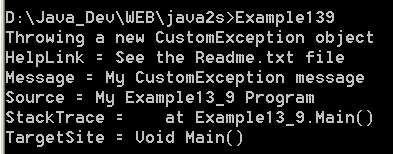illustrates a custom exception

/*
Mastering Visual C# .NET
by Jason Price, Mike Gunderloy
Publisher: Sybex;
ISBN: 0782129110
*/
/*
Example13_9.cs illustrates a custom exception
*/
using System;
// declare the CustomException class
class CustomException : ApplicationException
{
public CustomException(string Message) : base(Message)
{
// set the HelpLink and Source properties
this.HelpLink = "See the Readme.txt file";
this.Source = "My Example13_9 Program";
}
}
public class Example13_9
{
public static void Main()
{
try
{
// throw a new CustomException object
Console.WriteLine("Throwing a new CustomException object");
throw new CustomException("My CustomException message");
}
catch (CustomException e)
{
// display the CustomException object's properties
Console.WriteLine("HelpLink = " + e.HelpLink);
Console.WriteLine("Message = " + e.Message);
Console.WriteLine("Source = " + e.Source);
Console.WriteLine("StackTrace = " + e.StackTrace);
Console.WriteLine("TargetSite = " + e.TargetSite);
}
}
}
Related examples in the same category